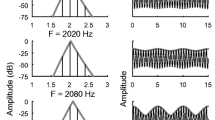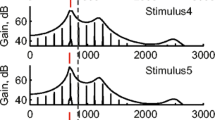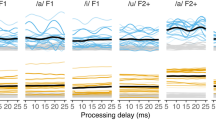Abstract
Although differences in fundamental frequencies (F0s) between vowels are beneficial for their segregation and identification, listeners can still segregate and identify simultaneous vowels that have identical F0s, suggesting that additional cues are contributing, including formant frequency differences. The current perception and computational modeling study was designed to assess the contribution of F0 and formant difference cues for concurrent vowel identification. Younger adults with normal hearing listened to concurrent vowels over a wide range of levels (25–85 dB SPL) for conditions in which F0 was the same or different between vowel pairs. Vowel identification scores were poorer at the lowest and highest levels for each F0 condition, and F0 benefit was reduced at the lowest level as compared to higher levels. To understand the neural correlates underlying level-dependent changes in vowel identification, a computational auditory-nerve model was used to estimate formant and F0 difference cues under the same listening conditions. Template contrast and average localized synchronized rate predicted level-dependent changes in the strength of phase locking to F0s and formants of concurrent vowels, respectively. At lower levels, poorer F0 benefit may be attributed to poorer phase locking to both F0s, which resulted from lower firing rates of auditory-nerve fibers. At higher levels, poorer identification scores may relate to poorer phase locking to the second formant, due to synchrony capture by lower formants. These findings suggest that concurrent vowel identification may be partly influenced by level-dependent changes in phase locking of auditory-nerve fibers to F0s and formants of both vowels.









Similar content being viewed by others
REFERENCES
Arehart KH, King CA, McLean-Mudgett KS (1997) Role of fundamental frequency differences in the perceptual separation of competing vowel sounds by listeners with normal hearing and listeners with hearing loss. J Speech Lang Hear Res 40:1434–1444
Assmann PF, Summerfield Q (1990) Modeling the perception of concurrent vowels: vowels with different fundamental frequencies. J Acoust Soc Am 88:680–697
Assmann PF, Summerfield Q (1994) The contribution of waveform interactions to the perception of concurrent vowels. J Acoust Soc Am 95:471–484
Bernstein JG, Oxenham AJ (2005) An autocorrelation model with place dependence to account for the effect of harmonic number on fundamental frequency discrimination. J Acoust Soc Am 117:3816–3831
Bruce IC, Sachs MB, Young ED (2003) An auditory-periphery model of the effects of acoustic trauma on auditory nerve responses. J Acoust Soc Am 113:369–388
Cariani P (2004) A temporal model for pitch multiplicity and tonal consonance. In: Lipscomb SD, Ashley R, Gjerdingen RO, Webster P (eds) Proceedings of the 8th International Conference on Music Perception and Cognition. SMPC, Evanston, pp 310–313
Cariani PA, Delgutte B (1996) Neural correlates of the pitch of complex tones. I. Pitch and pitch salience. J Neurophysiol 76:1698–1716
Carney LH (1993) A model for the responses of low-frequency auditory-nerve fibers in cat. J Acoust Soc Am 93:401–417
Carney LH (1999) Temporal response properties of neurons in the auditory pathway. Curr Opin Neurobiol 9:442–446
Chintanpalli A, Heinz MG (2013) The use of confusion patterns to evaluate the neural basis for concurrent vowel identification. J Acoust Soc Am 134:2988–3000
Chintanpalli A, Jennings SG, Heinz MG, Strickland EA (2012) Modeling the anti-masking effects of the olivocochlear reflex in auditory nerve responses to tones in sustained noise. J Assoc Res Otolaryngol 13:219–235
de Cheveigné A (2005) Pitch perception models. In: Plack CJ, Oxenham A, Fay RR, Popper AN (eds) Pitch - Neural coding and perception. Springer, New York, pp 169–223
Goldstein JL (1973) An optimum processor theory for the central formation of the pitch of complex tones. J Acoust Soc Am 54:1496–1516
Heinz MG, Zhang X, Bruce IC, Carney LH (2001) Auditory-nerve model for predicting performance limits of normal and impaired listeners. ARLO 2:91–96
Johnson DH (1980) The relationship between spike rate and synchrony in responses of auditory-nerve fibers to single tones. J Acoust Soc Am 68:1115–1122
Kawase T, Delgutte B, Liberman MC (1993) Antimasking effects of the olivocochlear reflex. II. Enhancement of auditory-nerve response to masked tones. J Neurophysiol 70:2533–2549
Keilson SE, Richards VM, Wyman BT, Young ED (1997) The representation of concurrent vowels in the cat anesthetized ventral cochlear nucleus: evidence for a periodicity-tagged spectral representation. J Acoust Soc Am 102:1056–1071
Klatt DH (1980) Software for a cascade/parallel formant synthesizer. J Acoust Soc Am 67:971–995
Krishna BS, Semple MN (2000) Auditory temporal processing: responses to sinusoidally amplitude-modulated tones in the inferior colliculus. J Neurophysiol 84:255–273
Larsen E, Cedolin L, Delgutte B (2008) Pitch representations in the auditory nerve: two concurrent complex tones. J Neurophysiol 100:1301–1319
Liberman MC (1978) Auditory-nerve response from cats raised in a low-noise chamber. J Acoust Soc Am 63:442–455
Licklider JCR (1951) A duplex theory of pitch perception. Experientia 7:128–133
Louage DHG, van der Heijden M, Joris PX (2004) Temporal properties of responses to broadband noise in the auditory nerve. J Neurophysiol 91:2051–2065
Makary CA, Shin J, Kujawa SG, Liberman MC, Merchant SN (2011) Age-related primary cochlear neuronal degeneration in human temporal bones. J Assoc Res Otolaryngol 12:711–717
Meddis R, Hewitt MJ (1991) Virtual pitch and phase-sensitivity studied using a computer model of the auditory periphery. I. Pitch identification. J Acoust Soc Am 89:2883–2894
Meddis R, Hewitt MJ (1992) Modeling the identification of concurrent vowels with different fundamental frequencies. J Acoust Soc Am 91:233–245
Meddis R, O’Mard L (1997) A unitary model of pitch perception. J Acoust Soc Am 102:1811–1820
Micheyl C, Oxenham AJ (2010) Pitch, harmonicity and concurrent sound segregation: psychoacoustical and neurophysiological findings. Hear Res 266:36–51
Miller RL, Schilling JR, Franck KR, Young ED (1997) Effects of acoustic trauma on the representation of the vowel/ɛ/in cat auditory nerve fibers. J Acoust Soc Am 101:3602–3616
Nelson PC, Carney LH (2004) A phenomenological model of peripheral and central neural responses to amplitude-modulated tones. J Acoust Soc Am 116:2173–2186
Palmer AR (1990) The representation of the spectra and fundamental frequencies of steady-state single- and double-vowel sounds in the temporal discharge patterns of guinea pig cochlear-nerve fibers. J Acoust Soc Am 88:1412–1426
Palmer AR (1992) Segregation of the responses to paired vowels in the auditory nerve of the guinea pig using autocorrelation. In: Schouten MEH (ed) The Auditory Processing of Speech: From Sounds to Words. Mouton-deGruyter, Berlin, pp 115–124
Peterson GE, Barney HL (1952) Control methods used in the study of vowels. J Acoust Soc Am 24:175–184
Pressnitzer D, Patterson RD, Krumbholz K (2001) The lower limit of melodic pitch. J Acoust Soc Am 109:2074–2084
Sachs MB, Young ED (1979) Encoding of steady-state vowels in the auditory nerve: representation in terms of discharge rate. J Acoust Soc Am 66:470–479
Scheffers M (1983) Sifting vowels: auditory pitch analysis and sound segregation. Dissertation, Groningen University
Schmiedt RA, Mills JH, Boettcher FA (1996) Age-related loss of activity of auditory-nerve fibers. J Neurophysiol 76:2799–2803
Smalt CJ, Heinz MG, Strickland EA (2014) Modeling the time-varying and level-dependent effects of the medial olivocochlear reflex in auditory nerve responses. J Assoc Res Otolaryngol 15:159–173
Studebaker GA (1985) A ‘rationalized’ arcsine transform. J Speech Hear Res 28:455–462
Summers V, Leek MR (1998) F0 processing and the separation of competing speech signals by listeners with normal hearing and with hearing loss. J Speech Lang Hear Res 41:1294–1306
Tan Q, Carney LH (2005) A phenomenological model for the responses of auditory-nerve fibers. II. Nonlinear tuning with a frequency glide. J Acoust Soc Am 114:2007–2020
Vongpaisal T, Pichora-Fuller MK (2007) Effect of age on F0 difference limen and concurrent vowel identification. J Speech Lang Hear Res 50:1139–1156
Young ED, Sachs MB (1979) Representation of steady-state vowels in the temporal aspects of the discharge patterns of populations of auditory-nerve fibers. J Acoust Soc Am 66:1381–1403
Zhang X, Heinz MG, Bruce IC, Carney LH (2001) A phenomenological model for the responses of auditory-nerve fibers. I. Nonlinear tuning with compression and suppression. J Acoust Soc Am 109:648–670
Zilany MS, Bruce IC (2006) Modeling auditory-nerve responses for high sound pressure levels in the normal and impaired auditory periphery. J Acoust Soc Am 120:1446–1466
Zilany MS, Bruce IC (2007) Representation of the vowel/ɛ/in normal and impaired auditory nerve fibers: model predictions of responses in cats. J Acoust Soc Am 122:402–417
Zilany MS, Bruce IC, Nelson PC, Carney LH (2009) A phenomenological model of the synapse between the inner hair cell and auditory nerve: long-term adaptation with power-law dynamics. J Acoust Soc Am 126:2390–2412
ACKNOWLEDGMENTS
This work was supported (in part) by research grants R01 DC000184 and P50 DC000422 from NIH/NIDCD and by the South Carolina Clinical and Translational Research (SCTR) Institute, with an academic home at the Medical University of South Carolina, NIH/NCRR Grant number UL1 RR029882. This investigation was conducted in a facility constructed with support from Research Facilities Improvement Program Grant Number C06 RR14516 from the National Center for Research Resources, National Institutes of Health. We thank Ian C. Bruce and Emily Buss for sharing MATLAB code, Michael G. Heinz for his valuable suggestions, Tyler W. Eisenhart for data collection, and Skyler G. Jennings and William J. Bologna for providing valuable comments on a previous version of the manuscript.
Author information
Authors and Affiliations
Corresponding author
Rights and permissions
About this article
Cite this article
Chintanpalli, A., Ahlstrom, J.B. & Dubno, J.R. Computational Model Predictions of Cues for Concurrent Vowel Identification. JARO 15, 823–837 (2014). https://doi.org/10.1007/s10162-014-0475-7
Received:
Accepted:
Published:
Issue Date:
DOI: https://doi.org/10.1007/s10162-014-0475-7




